
What’s the role of horror in emerging art?
Growing up, I was surrounded by monsters.
My father, a physicist, loved horror and sci fi. My mother, an artist, was writing a thesis about artist Max Earnst and surrealism. On weekends we’d alternately visit used bookstores to buy stacks of pulp novels, or head to a museum. At home, we’d watch Creature Feature, a showcase of classic scary movies.
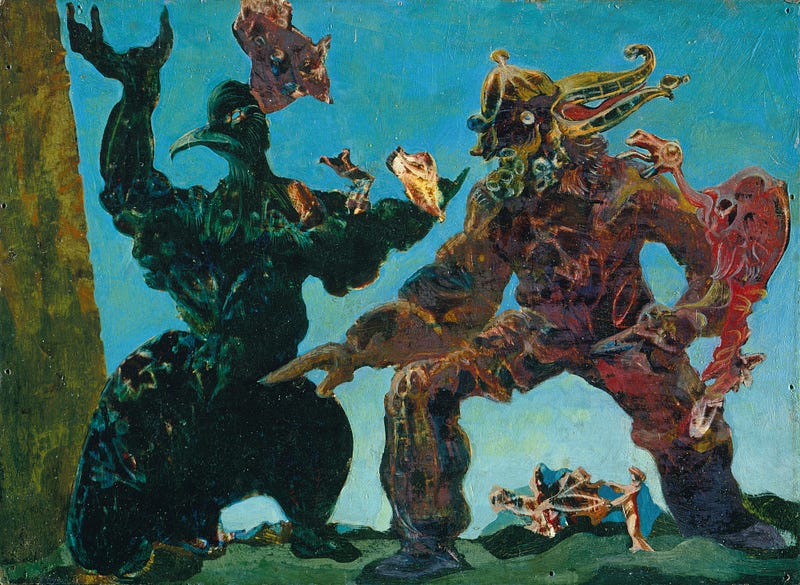 The
Barbarians, Max Earnst, 1937
The
Barbarians, Max Earnst, 1937 The
Creature from the Black Lagoon, 1954
The
Creature from the Black Lagoon, 1954At the time these experiences were quite distinct: selecting from musty stacks of yellowing paperbacks, viewing paintings on pristine gallery walls, sacking out in front of the TV that inhabited the disused white brick fireplace in our Miami living room.
But now, our media delivery systems have merged. Computer screens, mobile phones, VR headsets are all conduits for many types of content: high and low, sublime and schlock.
One the one hand, these similarities in interface flatten out our encounters with the supernatural in both art and entertainment. On the other, they offer new ways to bring us convincingly face-to-face with fictional beasts. Makers are experimenting with ways to combine digital with analog to deepen participants’ experiences. Techniques honed in haunted houses and escape rooms now bleed over into museums and festivals, straddling the line between the avant-garde and pop entertainment.
Take this year’s Tribeca Immersive Virtual Arcade—rife with creatures of all kinds: ghosts, aliens, gods, snaky hallucinations. Some of these were terrifying, others adorable. I spoke to a few of the creators:
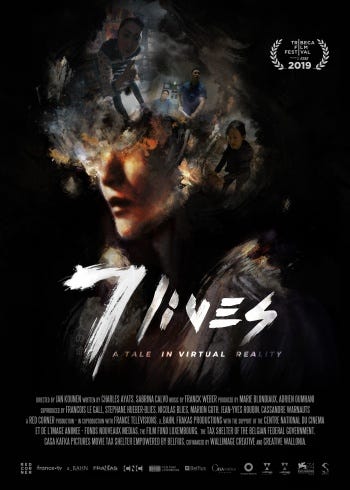
7 Lives is a VR experience set in a Tokyo subway station. At Tribeca, participants sat on a chair inside a booth decorated like a train and put on a headset.
“There’s no such thing as a scenario in 7 Lives,” explained Marie Blondiaux, one of the project’s producers. “You go through a young girl’s mind and a tragedy is about to happen on the subway station. Just after the tragedy, you will be able to go through the minds of those around you. The idea is that this tragedy makes their worst memory loop. You can help them go through these loops, these traumatic memories, and find peace.”
In practice, this means staring at a variety of colorful phantoms hovering above the platform for long enough to swoop into each one of them and be encompassed in their most disturbing life moments. These are unpleasant at best and frightening at worst: a mother yelling, a colleague getting too close for comfort, a wolf-like dog barking right in your face. This last one was the least comfortable for me; I found myself shutting my eyes and trying to look away. “People have their fear climax in very different scenes. It’s interesting.” she said.
But persevering was key to making it through. Only by stilling myself and watching could I proceed to the next scene—in each case a peaceful landscape. This effect was both beautiful and disorienting, as the scenes looked fuzzy until I was calm.
Blondieax affirmed that the quality of the participant’s focus is key to the narrative design of 7 Lives. It’s about “How can you be really attentive?” she said. The piece has “this dynamic effect that allows you to focus only if you are stable. We did this in the narrative, from the memories and trauma scenes to the moment of peace, making you really available to what is around. This is inspired by Shintoism, the Japanese philosophy. …In Shintoism, dimensions are totally equal, and they can appear in one another. Shintoism is a philosophy of attention. You can get another dimension when you pay attention.” She noted that while there are characters talking in the experience, they kept it in Japanese for English-speaking participants so that they would not focus on the meaning of the words, to make the experience more visceral and “sensorial.”
I asked her what the team hoped participants would take away from the experience. “We wanted it to be about how to find a way to lead and accept life as it is through the others’ experience,” she said. “Know the others, and you will know yourself.”
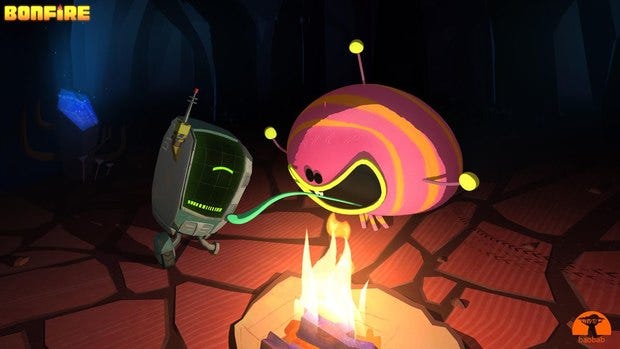
If 7 Lives is unnerving and a bit triggering, Bonfire is resolutely cute. Viewers enter a room fabricated to look like an alien planet, and put on a headset and hand controllers to find themselves crash-landed there in the company of a cheeky robot played by comedian Ali Wong.
Off in the dark distance, a creature approaches—who turns out to be endearing alien Pork Bun. After feeding and playing with Pork Bun for awhile, participants are asked to decide: Will you turn this planet over to Earthlings who have ruined their own and need a new home? Or will you let the alien and kin stay unmolested?
I asked Eric Darnell, the piece’s writer and director, how he translated his experience of directing tongue-in-cheek animated films such as Madagascar into the VR environment.
“We borrowed comedian terminology,” he said. “We had a lot of AI to make everything mesh and work wherever the viewer is. In comedy, you refer to ‘chunks’ — a set of ideas — and the bits within the chunks. A comedian able to read a crowd may say, ‘they are going to like this chunk and then that chunk.’ If a viewer was doing an activity that pushed in a certain direction, we’d push into a certain chunk. If they moved in a different direction, they’d go into a different chunk.”
He likened the dynamic between the viewer and Pork Bun to “feeding a squirrel and gaining its trust. “I wanted people to develop a relationship with the characters so that the viewer feels like they matter.”
“Are you rooting for the Earth or the aliens?” I asked.
“Like so many of the questions that are interesting about life, there is no one correct answer,” he said. “How can I put the viewer in a situation where they are under pressure that will maybe reveal something about themselves? That’s the goal. Hopefully you are enough engaged in the experience that you feel some weight in the decisions you make and you think about it.”
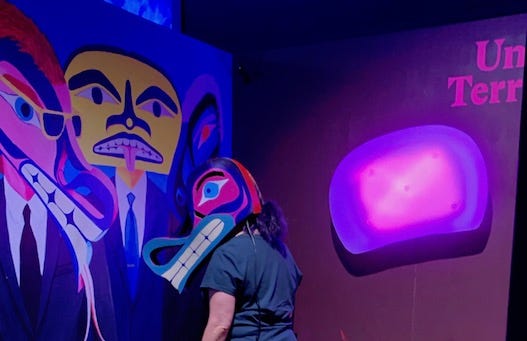 Unceded
Territories. Photo by Jessica Clark
Unceded
Territories. Photo by Jessica ClarkIn Unceded Territories, participants themselves unwittingly become the monster. They are asked to don a mask that is the VR headset and enter a lively technicolor space—where circumstances rather swiftly go wrong.
I spoke with Paisley Smith, who created the piece in collaboration with noted Canadian artist Lawrence Paul Yuxweluptun, who is of Coast Salish and Okanagan descent. Smith identifies herself as queer Canadian filmmaker and virtual reality creator of Indian heritage based in Los Angeles and Vancouver, British Columbia. She notes that she grew up on the Unceded Territories of the Musqueam, Squamish and Tsleil-Waututh First Nations.
This VR experience complements an exhibit and book of the same name featuring Yuxweluptun’s paintings, drawings and other media. She first encountered his work when studying early VR pioneers from the ’80s and ’90s, and “got excited about these older pieces and the way the art evolved with tech theory. It was experimental and creative—seemed like artists were having a lot of fun,” she said. “The tech industry is so influenced by finance now; it felt like a different era then.”
Yuxweluptun’s work deals with indigenous land rights, and Smith calls this piece “confrontational.” Unceded Territories is “about colonization and climate change,” she says. “You can see how the person wearing the headset embodies the super-predator, the oil barons, the corporations. You can see on the wall that they’re in suits. You embody the “one percent.” As you create and discover the world, you are destroying it with oil and fire. It’s not subtle at all—but I think it’s a good way of thinking about your role in our current climate.”
 Gymnasia
installation. Photo by Jessica Clark.
Gymnasia
installation. Photo by Jessica Clark.While each of these three pieces had a moral, perhaps the purest scary fun in this exhibit was Gymnasia, a co-production of the acclaimed Felix & Paul Studios and the National Film Board of Canada. Headsets for this piece were tucked into a room in the back corner of the exhibition, overseen by a creepy mannequin, with ghostly projections wreathing the walls.
Once in the experience, participants find themselves inside a rotting school gym, complete with self-bouncing basketballs, a supernatural singing companion and—Eek! Don’t look down!—a baby with a butterfly for eyes. There’s not much interaction here, mostly an eerie soundtrack, plus the thrill of looking around at the gorgeous decay and penetrating gaze of the spooks. While I didn’t get to speak with the makers of the piece, I did have an encounter with an errant spirit that they sent out to wander the halls.
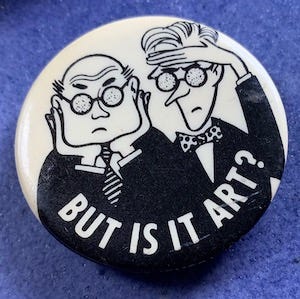
So—are these pieces art? How do we know? Where do we draw the line?
If the line is drawn at commercial viability, then perhaps Gymnasia and Bonfire are out—both are being distributed via the Oculus headset and other paid services. If it’s drawn at beauty and technical mastery, Gymnasia’s back in. If it’s drawn at the piece’s ability to move you in new or unexpected ways, then perhaps 7 Lives is the most artistic of these pieces, at least for me. Unceded Territories was created with a bonafide artist. Does that prove anything?
Or maybe these are the wrong questions altogether. Maybe a more interesting question is: What do we need monsters for?
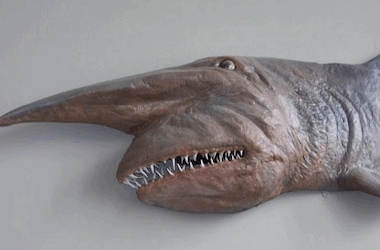
In my dad’s last years, he had trouble walking and spent a lot of time in bed, a giant iMac parked on the table next to him. He didn’t like to go out much. The computer became his primary interface to the world.
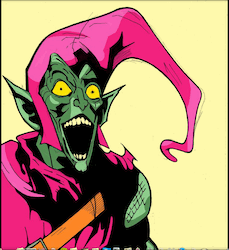
He developed a strange hobby: collecting pictures of monsters from the internet. He’d download these in great quantities and then feed them into a program that displayed them on his desktop every few minutes. That way, he’d wake up, or look away from the TV, and there’d be a fresh beast on the screen waiting for him. He’d keep a few of his most recent favorite monsters on his desktop to show visitors, and would ask them for monster-related search terms. These are some of the ones he picked right before he died. He seemed to be on a goblin kick.
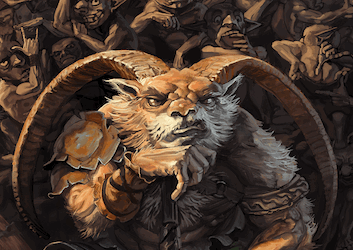
I asked him why he liked monsters so much, and he replied: “It’s something new.” The monsters were surprising in their variety and expression. While the artistic quality might vary from monster to monster, in the aggregate, they offered him delight.
This was a strange legacy, to say the least. The computer itself felt haunted, capable of spewing up creatures unprompted, a portal to obsession. I scrubbed it clean and stored all the images on an external hard drive—perhaps my own art project in waiting, or perhaps a Pandora’s box.
I was reminded of this by Where There’s Smoke, which premiered at Tribeca. Created by Lance Weiler, it centers around his own strange legacy: a collection of photos of blazes taken by his father, a volunteer firefighter. Part escape room, part haunted house, the piece invites participants to interact with these and other artifacts to try to solve a puzzle: Who set the fires in Weiler’s childhood home and family van?
This complex and meditative experience is made even more puzzling by the fact that his father enthusiastically helped with its creation up until his death by cancer. Participants can launch fragments of interviews to play through interactions in the space with such objects as a rotary phone, a cassette tape, and a camera. They have to work together both to assemble a narrative which is projected on a screen and to prompt a door to the next room to open.
The intimacy and originality of this work is striking — as is the fact that it immerses participants with nary a headset in sight. The space and experience feel fully analog; the code that triggers which clips will play in response to participants’ actions is invisible on the front end.
Where There’s Smoke was designed to cross the lines between art and something new: a space to help healthcare practitioners, patients and loved ones to make and share stories of healing. The installation is set to tour to museums, festivals, and hospitals.
Did Weiler’s father set the fires? He still doesn’t know, and so the group I experienced the piece with left equally puzzled. But by prompting us to pick and draw a treasured object to save from our own hypothetical fire, and to explain its importance to another participant, Where There’s Smoke? made us all contemplate memory, childhood, and loss — as well as the horror of what it might mean if the monsters we grew up with were actually those most supposed to protect us.
Photo (banner): Michio Morimoto
Immerse is an initiative of the MIT Open DocLab and The Fledgling Fund, and it receives funding from Just Films | Ford Foundation and the MacArthur Foundation. IFP is our fiscal sponsor. Learn more here. We are committed to exploring and showcasing media projects that push the boundaries of media and tackle issues of social justice — and rely on friends like you to sustain ourselves and grow. Join us by making a gift today.